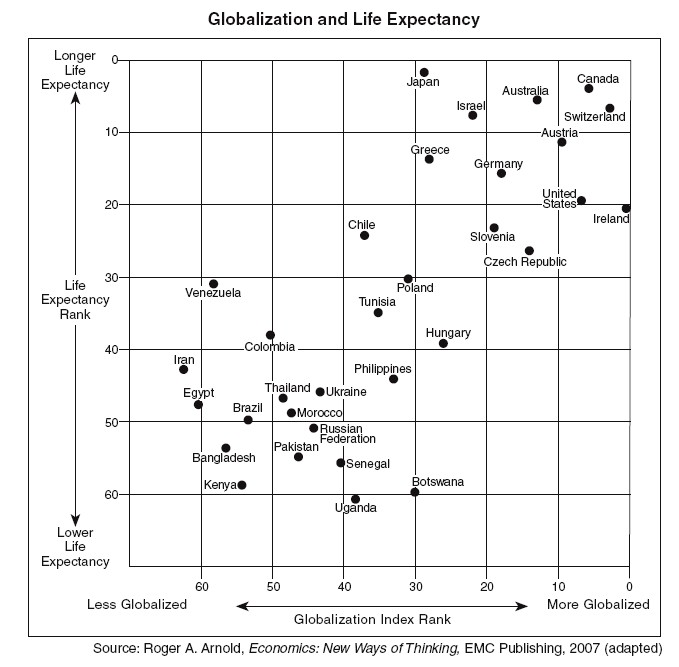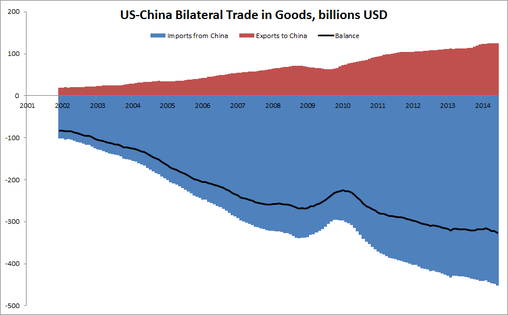globalization & Economy
|
In the 1700s, it took over 3 months to communicate with China. Now a person can send information instantaneously through email or Skype. The vast world doesn't seem as big because of improvement in technology and information. This is known as globalization. Globalization is the process of international integration arising from the interchange of world views, products, ideas and other aspects of culture.
Globalization allows for easier trade between countries and as a result trade has increased dramatically. Things that are made in China can be shipped rather easily now compared to the 1700s. To increase trade many countries have decided not to have tariffs on other countries goods, this is known as free trade. For example the United States doesn't have tariffs on Chinese goods. No tariffs also allows for companies to easily spread their goods throughout the world. John Deere does business in the USA, Canada, Europe, Brazil, Russia, India, and China. John Deere would be considered a multinational corporation. A multinational corporation is a company with businesses located around the world. Globalization also allows for economic interdependence. Economic interdependence is when one country specializes in a good or service. In Iowa we specialize in making farm equipment while China may specialize in clothing manufacturing. Each country excels at what they do best allowing for greater production of goods. Globalization has also led to some other surprising changes as well. The chart on the right can show another positive attribute of globalization. You may see a correlation between globalization and life expectancy. STOP AND ANSWER QUESTIONS |
Globalization Video |
Negatives of GlobilizationAlthough there are many positive attributes of globalization there are also some negative aspects of it as well. international trade creates jobs for exporting industries but eliminates them in other others, as cheaper foreign goods displace domestic products. Job losses are especially high in manufacturing.
Labor represents one of the highest business costs in producing products. The EPI (Economic Policy Institute) reported that expanded world trade -- which opens markets to goods produced in countries where workers earn far less than their domestic competitors -- depresses the wages of domestic workers as their employees try to reduce costs to compete more effectively with overseas firms. When imports exceed exports, a nation's trade deficit rises. (Deficit: he amount by which something, especially a sum of money.) Using the U.S. as an example, the U.S. runs a trade deficit it must borrow from overseas lenders to finance the difference, which increases foreign debt that the nation must pay with interest. Higher foreign debts and their accompanying interest payments threaten long-term living standards, according to the EPI. STOP AND ANALYZE CHART AND ANSWER QUESTIONS. The World Trade Organization and the World Bank report that the years since 1980 have seen the most growth in liberalized trade, in which international trading activities expand as trade barriers fall. However, world poverty has risen during that same period. The World Bank reports that the number of people throughout the world living on less than $2 a day has risen by about 50 percent since 1980. In addition, a growing number of people are living on less than $1 a day. STOP AND WATCH VIDEO AND ANSWER QUESTIONS. |
CHINA CollectiNG on US DEBT? |
Resources (Text info on website taken from websites below)
Hall, Shane. "Negative Effects of World Trade." EHow. Demand Media, 07 May 2011. Web. 12 Apr. 2015. <http://www.ehow.com/info_8376212_negative-effects-world-trade.html>
Hall, Shane. "Negative Effects of World Trade." EHow. Demand Media, 07 May 2011. Web. 12 Apr. 2015. <http://www.ehow.com/info_8376212_negative-effects-world-trade.html>


